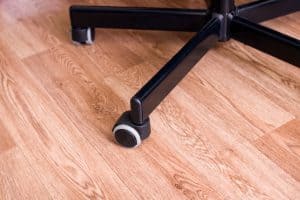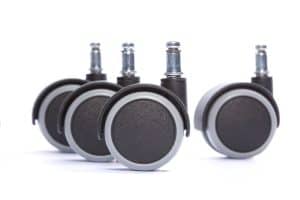If you’ve ever found yourself frustrated with a stationary office chair, you’ve likely considered putting on some wheels, also known as casters, to make it easier to maneuver across the floor.
While the job may seem easy, it’s actually a tricky one, which is why we’ve compiled this detailed guide on how to put wheels on a chair. Whether it’s putting the existing casters back onto a chair, replacing old ones with a new set, or installing casters on a chair that didn’t previously have them, we got you covered.
Putting the Wheels Back on a Chair
Sometimes you may want to take out the casters to clean them thoroughly. In this situation, before putting them back, first make sure that they are still usable.
Examine the casters for any signs of damage on both the wheels and the screw. You can also put them on the floor and cover them with a flat object (a big book, for example) to see whether it covers each of them entirely. If yes, you can put your old wheels back onto the chair.
If not, you’ll see the book leaning more on the side. This just means your old casters are all worn out, and you need to replace them. In that case, go straight to the section on how to put new wheels on an office chair.
If you decide that your old casters can still be used, here are a few tips on how to put them back onto the chair.
Use Lubricant
When putting the wheels back onto a chair, a bit of WD-40 lubricant in a spray bottle can do miracles. Spray a very tiny amount into the chair base socket by placing the straw of the spray into the socket, and spraying a small amount of lubricant inside. This should help the wheels click into their place without too much hassle.
Push in the Casters
Use your hand to push the casters back into their designated sockets. With a well-lubricated stem, this shouldn’t be much of a nuisance. Simply align the screw with the hole and push. If the caster doesn’t pop into its place, tap it gently with a rubber hammer.
Putting New Wheels on a Chair
If you’ve decided to get a new set of casters due to the regular wear and tear of the old ones, here are some important considerations to keep in mind.
Take the Measurements of Your Current Casters
Find the exact model of the old casters (easier said than done) or use a ruler to measure their stem (the small metal piece that connects them to the chair). Is the steam griped or threaded? If it’s threaded, the caster should be screwed in, while the grip-steam casters need to be pushed in. Then, measure the wheel size from front to back. Most wheels are between two and three inches in size.
With these two measurements, you will be able to choose the right set of new casters for your chair.
Choose the New Wheels
Sometimes, smaller wheels have trouble rolling around, in which case you should implement larger wheels.
Moreover, most chairs come with double plastic wheels. However, plastic casters wear and tear more quickly and can damage some floors. One solution would be switching to single rollerblade wheels. They’re more durable, won’t damage hard floors, move more easily even over rugs, and don’t need to be cleaned as often as plastic ones.
If you plan to roll your chair over a carpet, you can purchase casters designed for carpets and other soft surfaces. The same goes for hard floors — there are special casters for hardwood floors that you can buy, although the silicone rollerblade model is also a good solution.
Once you have the new casters in your hands, it’s time to replace the old ones. Either follow the instructions by the manufacturer (if provided) or read our explanation in the previous section.
The steps are the same as with old casters. First lubricate the socket in the base, and then push the caster in by hand or using a rubber hammer.
Implementing Wheels on a Wheeless Chair
Things can get a bit more complicated if you want to put wheels on a chair that has no wheels. It can be done, but there are some important considerations. For instance, depending on the chair and floor type, you need to choose the right casters.
In this chapter, we’ll look at three types of casters you can install on most chairs.
Grip-Ring Post Casters
Grip-ring post casters are best combined with wooden furniture. They have a metal stem with either a threaded rod or a grip ring.
The grip-ring post casters can be single-wheels, like the Shepherd Hardware model, or double-wheels, like the Sipstick rubber caster. It’s also possible to purchase only stems if you already have functioning wheels.
Installation
Before installing the casters, you should ensure that the furniture leg to which you want to add a caster matches the size of the caster screw size.
Most grip-ring casters’ stems fit into 1.5 inches-wide holes. If your chair’s leg is too thin to support a hole of this size, this type of caster is not the right choice. However, the majority of chair legs can support a 1.5-inch hole.
Once you have the casters with the correct stem size, get a power drill the same size as your caster’s post sleeve and drill a hole at the bottom of the chair’s leg. Today, most people can quickly and efficiently get the job done with a cordless power drill model.
After this, grab your caster and look for a metal sleeve around the post. Remove the sleeve and insert the caster into the freshly drilled hole. To secure the caster better, use a rubber mallet.
Finally, put the caster into the sleeve and push the wheel by hand or hit it gently with the rubber mallet until you’re certain the grip ring is secured.
Repeat the same steps for all casters and chair legs.
Threaded Stem Casters
Threaded stem casters, as the name suggests, have threaded rods that need to match the nut sleeve to be able to hold the caster in place. Their installation is simple and similar to the grip-ring style.
You can find threaded stem casters as single-wheel models of various diameters. Some models even come with a brake mechanism, as they’re usually made of rubber for heavy-duty use. You can choose from various designs.
To install threaded stem casters, you’ll also need to drill a sleeve-size hole in the chair legs, just like in the previous example. Check the instructions from above on how to drill the hole properly.
Once the holes are ready, tap the nut sleeve with a rubber hammer. Make sure it fits in tight; otherwise, screwing the caster in will be difficult.
The next step is inserting the caster into the sleeve and rotating it clockwise as far as possible. Sometimes, threaded casters come with a nut that goes between the metal on the wheel and the stem, making it easier to screw in the caster without damaging the wheel. To make things easier, you can use a wrench. Fixate the wheel with one hand, and at the same time, turn the wrench counterclockwise with the other hand.
Tighten the caster nut quite firmly so the stem doesn’t loosen up.
These casters can be a good choice for chairs with metal legs. However, drilling the holes will be much more challenging in this case. You’ll need the right type of drill suitable for drilling holes in metal and you must go slowly with the drill to reduce the chance of damaging the metal.
Screw-On Plate Casters
Screw-on plate casters are not a common choice for a chair, but we’ll still mention them, as you may prefer them over other models. They’re like any other casters, except they have a metal plate above the wheel. Screw-on plate casters can also be single-wheel, double-wheel, silicone, or even stainless steel.
These casters are often used for furniture like dressers or drawers with full bottoms because the casters are designed to support a lot of weight.
The screw-on plate casters have a metal plate on their metal mounting, and they are quite easy to install. First, you need to flip the chair upside down and align the caster wheels with the corners of the chair’s legs. This step is crucial because your chair may feel unstable and unbalanced if you make a mistake.
Each caster’s metal plate should have four holes where you need to put in the screws. Do this for each corner of each caster. The good thing about screw-on plate casters is that they are easy to remove if you decide on a different type of caster later on.
Final Word
Putting wheels on a chair is a low-effort project. Nevertheless, you still need to be careful, as there might be a few bumps along the road.
The important part is to figure out what kind of casters you want and to make sure to take precise measurements.
When installing casters on a chair for the first time, be careful while drilling the holes. Drilling is dangerous, and aside from hurting yourself, you can also completely ruin the leg of the furniture. We recommend grip-ring post casters for wooden chairs, while threaded stem casters could also be a good choice for chairs with metal legs.



